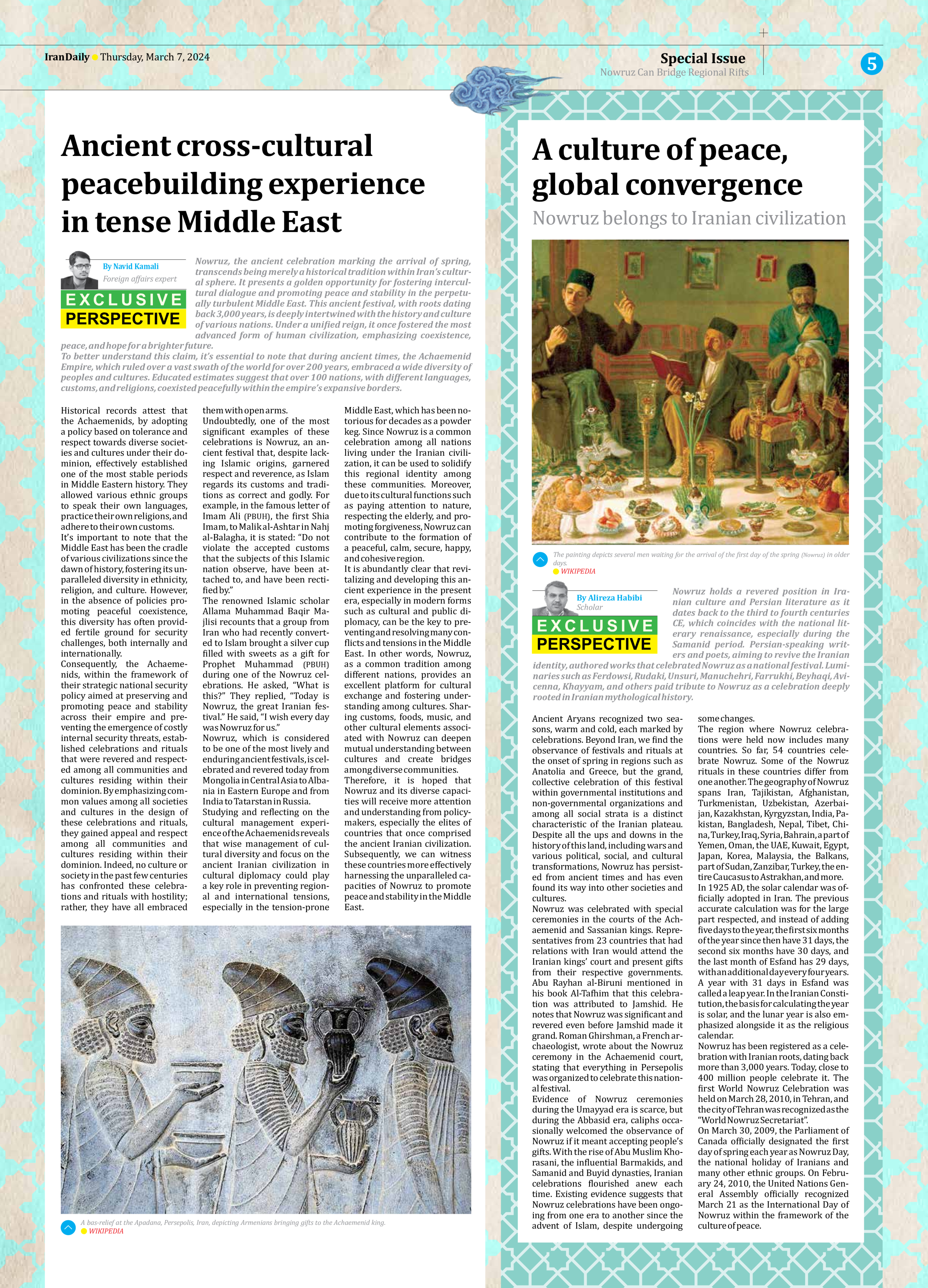
A culture of peace, global convergence
Nowruz belongs to Iranian civilization
By Alireza Habibi
Scholar
Nowruz holds a revered position in Iranian culture and Persian literature as it dates back to the third to fourth centuries CE, which coincides with the national literary renaissance, especially during the Samanid period. Persian-speaking writers and poets, aiming to revive the Iranian identity, authored works that celebrated Nowruz as a national festival. Luminaries such as Ferdowsi, Rudaki, Unsuri, Manuchehri, Farrukhi, Beyhaqi, Avicenna, Khayyam, and others paid tribute to Nowruz as a celebration deeply rooted in Iranian mythological history.
Ancient Aryans recognized two seasons, warm and cold, each marked by celebrations. Beyond Iran, we find the observance of festivals and rituals at the onset of spring in regions such as Anatolia and Greece, but the grand, collective celebration of this festival within governmental institutions and non-governmental organizations and among all social strata is a distinct characteristic of the Iranian plateau. Despite all the ups and downs in the history of this land, including wars and various political, social, and cultural transformations, Nowruz has persisted from ancient times and has even found its way into other societies and cultures.
Nowruz was celebrated with special ceremonies in the courts of the Achaemenid and Sassanian kings. Representatives from 23 countries that had relations with Iran would attend the Iranian kings’ court and present gifts from their respective governments. Abu Rayhan al-Biruni mentioned in his book Al-Tafhim that this celebration was attributed to Jamshid. He notes that Nowruz was significant and revered even before Jamshid made it grand. Roman Ghirshman, a French archaeologist, wrote about the Nowruz ceremony in the Achaemenid court, stating that everything in Persepolis was organized to celebrate this national festival.
Evidence of Nowruz ceremonies during the Umayyad era is scarce, but during the Abbasid era, caliphs occasionally welcomed the observance of Nowruz if it meant accepting people’s gifts. With the rise of Abu Muslim Khorasani, the influential Barmakids, and Samanid and Buyid dynasties, Iranian celebrations flourished anew each time. Existing evidence suggests that Nowruz celebrations have been ongoing from one era to another since the advent of Islam, despite undergoing some changes.
The region where Nowruz celebrations were held now includes many countries. So far, 54 countries celebrate Nowruz. Some of the Nowruz rituals in these countries differ from one another. The geography of Nowruz spans Iran, Tajikistan, Afghanistan, Turkmenistan, Uzbekistan, Azerbaijan, Kazakhstan, Kyrgyzstan, India, Pakistan, Bangladesh, Nepal, Tibet, China, Turkey, Iraq, Syria, Bahrain, a part of Yemen, Oman, the UAE, Kuwait, Egypt, Japan, Korea, Malaysia, the Balkans, part of Sudan, Zanzibar, Turkey, the entire Caucasus to Astrakhan, and more.
In 1925 AD, the solar calendar was officially adopted in Iran. The previous accurate calculation was for the large part respected, and instead of adding five days to the year, the first six months of the year since then have 31 days, the second six months have 30 days, and the last month of Esfand has 29 days, with an additional day every four years. A year with 31 days in Esfand was called a leap year. In the Iranian Constitution, the basis for calculating the year is solar, and the lunar year is also emphasized alongside it as the religious calendar.
Nowruz has been registered as a celebration with Iranian roots, dating back more than 3,000 years. Today, close to 400 million people celebrate it. The first World Nowruz Celebration was held on March 28, 2010, in Tehran, and the city of Tehran was recognized as the “World Nowruz Secretariat”.
On March 30, 2009, the Parliament of Canada officially designated the first day of spring each year as Nowruz Day, the national holiday of Iranians and many other ethnic groups. On February 24, 2010, the United Nations General Assembly officially recognized March 21 as the International Day of Nowruz within the framework of the culture of peace.







